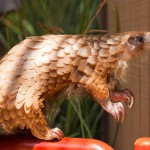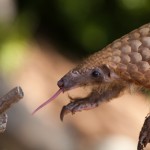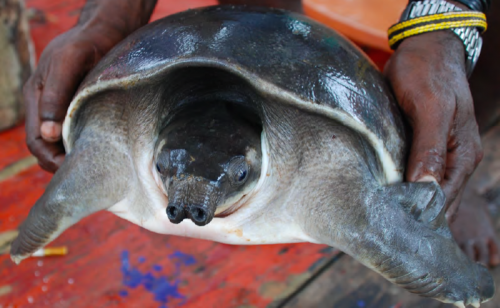
During a span of less than one week, Indonesian authorities have seized two massive hauls of protected Pig-nosed Turtles totaling 7,634 individuals.
The first incident occurred on January 17 when 2,350 pig-nosed turtles were seized in Jakarta’s Soekarno-Hatta Airport. They were headed for Shang Hai, China, via Singapore, in boxes labeled as “mangrove crabs”.
Just five days later, 5,284 pig-nosed turtles were confiscated in Bali at the Ngurah Rai airport, where they arrived on a flight from Mozes Kilangin airport in Timika, Papua. Three passengers were detained and questioned by police.
“The seizure is timely and stands as one example of a worrying illegal trade between wildlife-rich Indonesia and large consumer markets in China,” says Dr Chris R. Shepherd, Regional Director of TRAFFIC in Southeast Asia. “It is highly unlikely that Pig-nosed Turtles can withstand such enormous off take.”
Pig-nosed Turtles are totally protected by Indonesia’s national legislation, and are listed in Appendix II of the Convention on International Trade in Endangered Species of Wild Fauna and Flora (CITES). The Pig-nosed Turtle is classified Vulnerable by the IUCN Red List of Threatened Species™.
The rare Pig-nosed Turtle is prized in the exotic pet trade for its intriguing appearance, which features a prominent snout, resembling a pig. This species has flippers like a marine turtle, rather than clawed feet, and skin rather than scutes covering their shell. Also known as the Fly River Turtle or Pitted-Shell Turtle, the Pig-nosed Turtle (Carettochelys insculpta) is the only surviving species of the once widespread family Carettochelyidae. They are found only on the island of Papua (shared between Indonesia and Papua New Guinea) and Australia.
According to TRAFFIC, seizures involving thousands of baby pig-nosed turtles are most common between January and March, which is the ends of the nesting season in Indonesia, and warned that authorities should be especially attentive during this time.
“Given what we know about the seasonality of the illegal harvest and trade in this species, it is highly likely that more such attempts will be made in the near future”, says Dr. Shepherd. “We strongly encourage the authorities to punish offenders to the full extent of the law, to deter further smuggling of this threatened species.”
In its October 2014 report, Assessing the trade in Pig-nosed Turtles Carettochelys insculpta in Papua, Indonesia, TRAFFIC recorded 32 smuggling cases totaling more than 81,689 individual turtles during 2003 through 2012.
“Further highlighting the enormity of this illegal trade was one seizure occurring in Timika, Papua in 2009, which rescued 12 247 Pig-nosed Turtles (more than four times higher than average seizure numbers) bound for Jakarta.”
The crisis is compounded by misguided “captive breeding” operations in Papua, in which thousands of pig-nosed turtle eggs are stolen from the wild and “hatched” in captivity.
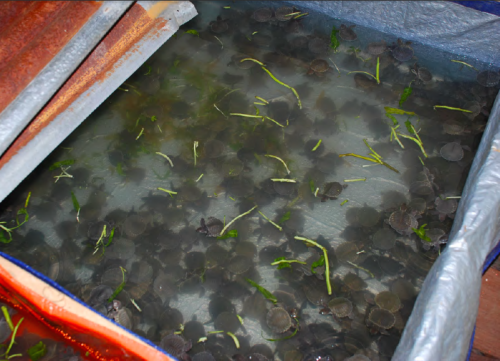
TRAFFIC researchers note, “None of the hatcheries observed in this study had permits authorised by BKSDA [Natural Resources Conservation Agency of Indonesia] to conduct their ranching operations. Anecdotal information from interviewed sources indicated that a few traders in Papua were carrying out captive breeding of Pig-nosed Turtles under legal licence. Claims were made that at least three traders in Jakarta were also captive breeding Pig-nosed Turtles, and offering them for sale according to a permitting and quota system. However, further information on the full status of these captive breeding operations could not be verified.”
However, TRAFFIC notes that according to the CITES Trade Database, Indonesia has only ever legally exported one shipment of 57 Pig-nosed Turtles for the purpose of trade in 2006 to the United States.
Following the launch of the report, two major smuggling attempts were foiled in January 2014. Indonesian officials seized more than 8,000 baby Pig-nosed Turtles hidden in suitcases suspected to be destined for Singapore and China, while authorities in Hong Kong intercepted a shipment of some 2,700 Pig-nosed Turtles coming from Jakarta, Indonesia, falsely declared as live tropical fish.
TRAFFIC recommends that Indonesian authorities increase their vigilance and take strong action against the illegal trade, at point of collection, through the trade chain to the final exporter. It also calls upon recipient countries, such as China, to increase their efforts in preventing the species from being smuggled in.
Dr. Shepherd warns, “When you buy a Pig-nosed Turtle for a pet, you are not only supporting illegal wildlife traders, but you are also directly contributing to the decline of this species in the wild.”

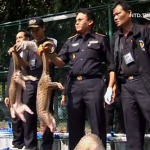
![Indonesia: Pangolin Smugglers Doing Their Dirty Work [Photos]](https://annamiticus.com/wp-content/uploads/2013/10/PangolinsArrive-150x150.jpg)
